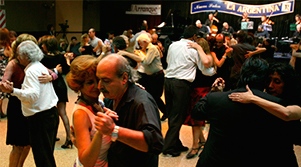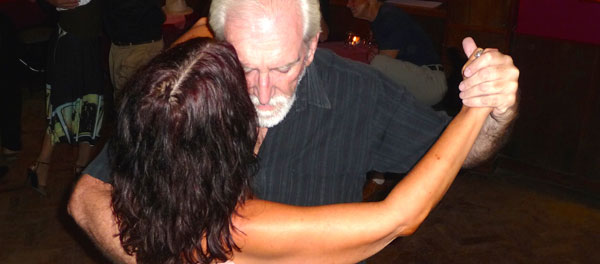
“Sueño Porteño” at 7 PM on Wednesdays has enjoyed great success since opening a few months ago. About four hundred dancers are gathered here. It is barely 9 PM and all seats are taken.
I am surprised to find an accommodating hostess (a rarity in most milongas) that leads me to the only table available – in the area where couples seat. I could move, she says, if a chair becomes available somewhere else. At most milongas the men, women, and couples sections are clearly separated. Not in this one, a refreshingly different touch. My neighbor greets me; an unusual social gesture in this city where people are friendly everywhere except at dance halls. He warns me: no one will invite me to dance where I am sitting. Satisfied with the refreshing ambiance and warmth of the people in this venue I wonder:
What to do? Just sit there and watch?
So I do, at least for now. I entertain myself watching the ways women wrap their arms around their partners. Styles range from surrounding his shoulders and neck, to arms a few inches below his shoulders, to an awkward looking oblique positioning of the arm across his back.
Enough watching. How do I get invited to dance here? How would I make it work from the “couples” area where the pista is split into two dance floors.
Walking around and scanning the environment seem like good ideas. I do, see a familiar face, “el muchacho del tio,” sitting as I turn the corner from one pista to the other. He recognizes me and invites me to dance. He is a good dancer without the airs. The tanda ends. I return to “couples” territory and sit.
Shall I take a trip to the far end of the pista? I do. A voice reaches me from behind. “Would you like to dance?” I turn my head and we recognize each other from dancing at El Beso six months before. He is also a bit disoriented about how this space works. But we both liked its energy.
As the evening progresses I realize that Julia Pugliese, the milonga organizer, is the energizer of this milonga. She has a background in theatre, someone tells me. With commanding presence and microphone in hand, she refers to women as “papusas” and to men as “galanes” (terms frequently used in old tango lyrics). Julia tells “galanes” to fetch a rose from several large vases to invite a “papusa” to dance adhering to the cabeceo code.
One “galan” finds my gaze and sends me a cabeceo from across the room. I notice he glances at the shoe bag under my chair. He tells me between songs – since I carry a shoe bag he assumed I was from academia (meaning I learned to dance in schools). Unlike me, he learned to tango in terraza and patio.” I know what he means. Terraza is the part of the house where he danced with cousins and family as he was growing up. So was the patio. I resonate to “terraza” and “patio” with a stream of memories from my own childhood home that I loved. Images of patios and terrazas have a bonding glue for porteños. Tango lyrics are filled with such imagery. No wander only portenos can fully know these meanings. He says gracias and disappears into the ocean of people.
I am pleasantly surprised to see Horacio. He is waving from afar. We are taking the same course at the National Academy of Tango — a music class. (Some people in the class are singers to be, others are poets in the making), Horacio and I are the only dancers. Last week our professor asked us to dance so the class could observe what steps went with the variations of the rhythm and the pauses in the music. Today we dance for real, that is for ourselves.
I feel part of this milonga barely two hours into it. I can tell people admire Julia. Now she is reading lyrics we found on our tables. Special touch.
For the other themed-tanda, Julia directs women to take a candy from trays placed on the pista. Papusas are to initiate the invite and give the candy to a chosen “galan.” Julia adds: “We women are givers, we give birth, we give to others throughout life; this candy represents our giving feminine essence.” This is no regular milonga. Julia knows how to handle a crowd, how to add artistic touches here and there.

The tanda of the candy is about to begin. I cabeceo a friendly face and learn, from this role reversal that I invited him with the certainty he would accept… because he was inviting me with an interested friendly look. ” The tanda of the candy, sung by Alberto Podestá is true candy for me. I had interviewed Podestá two years before when I learned that he was in his late teens when he recorded the ageless and poignant pieces we are dancing: “Nada”, “Tu el cielo y tu”, “Bajo un cielo de estrellas.”
I leave Sueño Porteño thinking other milongas will probably learn from this progressive one and become warmer and more flexible. Julia preserves the cabeceo code buy she does not insist on rigid sitting arrangements. She leads her milonga from the heart.
Tags: Dancing

